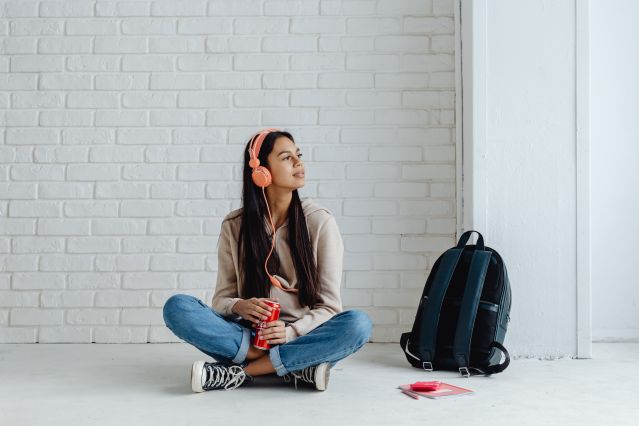Sex
How Does Music Relate to Teen Sexting?
Music is so common we don't often stop to think about what we are listening to.
Posted May 11, 2023 Reviewed by Vanessa Lancaster
Key points
- Almost 40 percent of top billboard songs contain sexual lyrics, and some genres have up to 65 percent of sexually objectifying themes.
- Recent research ties sexually explicit music and teenage sexing.
- Parents can use music as a bridge to have healthy conversations about sex with their teens.

This post was written with assistance by Christine Lee and Jane Shawcroft, Ph.D. students at UC Davis.
Music is woven into the fabric of our relationships and memories for many families. In my family (Jane), nothing stops an argument in its tracks like someone turning on my siblings' childhood favorite, the 60s folk group The Kingston Trio, and it isn't Christmas until we have blasted Alan Jackson’s “Let it be Christmas” and sung along slightly off-key.
Music can also be personal. As teenagers, we listened to music while driving to school, working on homework, hanging out with friends, and during sports. Music is so common we never really stop to think about what we are listening to. As parents, how often do we stop to think about what our families and teens are singing along to or about and what messages these lyrics send?
Perhaps this is unsurprising, but studiesi have found that almost 40 percent of top billboard songs contain sexual lyrics, with some genres having up to 65 percent of sexually objectifying themes. You might have heard popular songs such as Hozier’s “Take Me to Church,” with its purity culture critique, and the recent 2023 Grammy-award winning “Unholy” by Sam Smith and Kim Petras, which describes an unfaithful husband’s affair. Both are examples of mainstream songs with sexual lyrics frequently repeated on the radio.
Why does this matter? It’s common for parents today to worry about what their teenagers are seeing on social media platforms or TV, and often a lot of effort and care goes into trying to help teenagers develop a healthier relationship with media, as well as steering them away from bad influences.
Because of the prominent place of music in our society, it is easy to treat music, and highly sexual and sexually objectifying lyrics in particular, as white noise in the background of more important activities, despite research suggesting that music containsii more messages about sex than any other media content except pornography. It is easy to dismiss the lyrics and messages in a three-minute song as inconsequential. Our new research,iii published in March in Computers in Human Behavior, suggests that listening to highly sexual music influences teenagers' sexual risk-taking, specifically sexting.

Sexting–sending or receiving nude/partially nude pictures or sexually explicit written messages to others via texting, social network sites, apps, or other forms of communication such as email–has been linked to potentially severe consequences for teenagers, such as poor mental health, and the possibility of future exploitation (also known as sextortion).
Our recent study tracked the number of sexts sent and received from teenage participants for three years. In the first and last year of the study, we also asked teenagers about the music that they listened to and were able to quantify how sexually explicit or sexually objectifying the lyrics of their favorite artists were. For girls, our data did not find a relationship between listening to sexual music and sexting. However, the more teenage boys listened to sexually explicit music, the more likely they were to engage in sexting two years later.
So, what does this mean? Research suggests that boys are influencediv by what they see (and, in this case, hear) as “normal” sexual behavior from media influences and peers. Sexual lyrics may become an agent in normalizing that behavior. Girls, on the other hand, are often discouragedv from sexual behaviors, which might be why they are less likely to be influenced by music.
Although girls might not be directly impacted by listening to sexual lyrics, this does not mean they are not affected at all. Studies have shown that a common motivationvi for girls to sext is coercion, and boys are more likely to pressure girls into sending sexually explicit messages/pictures. In this way, sexually explicit music likely influences how all teenagers think about and participate in risky sexual behavior. This suggests that although our findings show that sexual lyrics are more predictive of boys’ sexting behavior, parents of all teenagers have reason to think about how the sexual nature of music might be influencing their teens.
Given these findings, what can parents do with this information? Importantly, it is difficult, if not impossible, to stop teenagers from ever hearing music with sexual lyrics. The goal for parents should be to pre-arm (think prepare) rather than cocoon (or completely shield) their teens. We offer a few suggestions along those lines:
- Parents need to remember that despite what it may seem, they have a lot of influence on their teens. Having an active role in shaping how teenagers think about risky sexual behaviors, such as sexting, may be difficult, but it is worth it.
- Knowing more about music's role in how teenagers think about sex and sexting should be seen as empowering rather than alarming, as it can help guide proactive parenting.
- Understanding that listening to sexual music lyrics is related to attitudes about and participation in risky sexual behaviors (sexting) indicates that music may be a helpful tool for breaching hard conversations, making music a valuable tool for parents.
 Source: Yarenci Hdz/Unsplash
Source: Yarenci Hdz/Unsplash

For example, if you are in the car with your teenager, sexually explicit music lyrics may create an opportunity to start a conversation about healthy attitudes about sex. Having an open and natural avenue to start conversations about sexual attitudes with adolescents is a way to understand what is going on in their world.
Perhaps if you hear lyrics that objectify women, this is a chance to talk to your teen about the importance of viewing women as individuals and not sexual objects (an important conversation for both boys and girls). A song about infidelity or casual sex might open a chance to talk about the importance of sex in the context of a healthy relationship, particularly marriage. and how sex is an important strengthening part of healthy marriages.
Although music is often overlooked when parents think about media parenting, sexual lyrics significantly shape teenagers' risky sexual behaviors, especially for boys. This hidden-in-plain-sight medium has great influence, but that doesn't have to be bad news. The next time you and your teen are in the car, singing along to your favorite song, perhaps follow up by bridging your favorite music to a meaningful conversation about healthy sexual behavior.
A version of this post appears at IFS.
References
[i] Primack, B. A., Dalton, M. A., Carroll, M. V., Agarwal, A. A., & Fine, M. J. (2008). Content analysis of tobacco, alcohol, and other drugs in popular music. Archives of Pediatrics and Adolescent Medicine, 162, 169–175.
[ii] Brown, J. D., L’Engle, K. L., Pardun, C. J., Guo, G., Kenneavy, K., & Jackson, C. (2006). Sexy media matter: Exposure to sexual content in music, movies, television, and magazines predicts Black and White adolescents’ sexual behavior. Pediatrics, 117, 1018–1027. https://doi.org/10.1542/peds.2005-1406
[iii] Keenan-Kroff, S. L., Coyne, S. M., Shawcroft, J., Sheppard, J. A., James, S. L., Ehrenreich, S. E., & Underwood, M. (2023). Associations between sexual music lyrics and sexting across adolescence. Computers in Human Behavior, 140, 107562. https://doi.org/10.1016/j.chb.2022.107562
[iv] Chia, S. C., & Gunther, A. C. (2006). How media contribute to misperceptions of social norms about sex. Mass Communication & Society, 9, 301–320.
[v] Shibley-Hyde, J., & Durik, A. M. (2000). Gender differences in erotic plasticity—evolutionary or sociocultural forces? Comment on baumeister (2000). Psychological Bulletin, 126(3), 375–379.
[vi] Englander, E. (2012). Low risk associated with most teenage sexting: A study of 617 18-year-olds. Retrieved on 26 August, 2019 from http://webhost.bridgew.edu/marc/sexting%20and%20coercion%20report.pdf.




